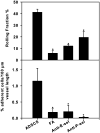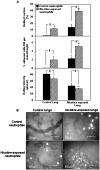Exposure to environmental tobacco smoke induces angiogenesis and leukocyte trafficking in lung microvessels
- PMID: 19263281
- PMCID: PMC3755616
- DOI: 10.1080/01902140802449729
Exposure to environmental tobacco smoke induces angiogenesis and leukocyte trafficking in lung microvessels
Abstract
Exposure to environmental tobacco smoke (ETS) is known to contribute to and exacerbate inflammatory diseases of the lung such as chronic obstructive pulmonary disease (COPD) and asthma. The effect of ETS on angiogenesis and leukocyte recruitment, both of which promote lung inflammation, was investigated using lung tissue from mice exposed to aged and diluted sidestream cigarette smoke or fresh air for 12 weeks and transplanted into dorsal skin-fold chambers in nude mice. Lung tissue from mice exposed to cigarette smoke for 12 weeks exhibited significantly increased vascular density (angiogenesis) associated with selectin-mediated increased intravascular leukocyte rolling and adhesion compared to fresh air-exposed lung tissue by intravital microscopy. Further, neutrophils from nicotine-exposed mice displayed significantly increased rolling and adhesion compared to control neutrophils in microvessels of nicotine-exposed lungs versus control lung microvessels, suggesting that nicotine in cigarette smoke can augment leukocyte-endothelial interactions. ETS-induced angiogenesis and leukocyte trafficking may play a key role in airway recruitment of inflammatory cells in ETS-associated disorders such as COPD bronchitis or asthma.
Conflict of interest statement
Figures




Similar articles
-
Selectin-dependent rolling and adhesion of leukocytes in nicotine-exposed microvessels of lung allografts.Am J Physiol Lung Cell Mol Physiol. 2003 Sep;285(3):L654-63. doi: 10.1152/ajplung.00448.2002. Epub 2003 Jun 6. Am J Physiol Lung Cell Mol Physiol. 2003. PMID: 12794008
-
A murine model to study leukocyte rolling and intravascular trafficking in lung microvessels.Am J Pathol. 2003 Jun;162(6):2019-28. doi: 10.1016/S0002-9440(10)64334-9. Am J Pathol. 2003. PMID: 12759257 Free PMC article.
-
Role of CXCL5 in leukocyte recruitment to the lungs during secondhand smoke exposure.Am J Respir Cell Mol Biol. 2012 Jul;47(1):104-11. doi: 10.1165/rcmb.2011-0260OC. Epub 2012 Feb 23. Am J Respir Cell Mol Biol. 2012. PMID: 22362385 Free PMC article.
-
Tobacco Smoke Induces and Alters Immune Responses in the Lung Triggering Inflammation, Allergy, Asthma and Other Lung Diseases: A Mechanistic Review.Int J Environ Res Public Health. 2018 May 21;15(5):1033. doi: 10.3390/ijerph15051033. Int J Environ Res Public Health. 2018. PMID: 29883409 Free PMC article. Review.
-
Health hazards of passive smoking.Annu Rev Public Health. 1988;9:47-70. doi: 10.1146/annurev.pu.09.050188.000403. Annu Rev Public Health. 1988. PMID: 3288240 Review.
Cited by
-
Environmental Tobacco Smoke Alters Metabolic Systems in Adult Rats.Chem Res Toxicol. 2016 Nov 21;29(11):1818-1827. doi: 10.1021/acs.chemrestox.6b00187. Epub 2016 Nov 9. Chem Res Toxicol. 2016. PMID: 27788581 Free PMC article.
-
Tobacco smoke induced COPD/emphysema in the animal model-are we all on the same page?Front Physiol. 2013 May 15;4:91. doi: 10.3389/fphys.2013.00091. eCollection 2013. Front Physiol. 2013. PMID: 23720629 Free PMC article.
-
Deficiency of endothelial heparan sulfates attenuates allergic airway inflammation.J Immunol. 2009 Sep 15;183(6):3971-9. doi: 10.4049/jimmunol.0901604. Epub 2009 Aug 26. J Immunol. 2009. PMID: 19710461 Free PMC article.
-
Cigarette smoke induces PTX3 expression in pulmonary veins of mice in an IL-1 dependent manner.Respir Res. 2010 Oct 4;11(1):134. doi: 10.1186/1465-9921-11-134. Respir Res. 2010. PMID: 20920344 Free PMC article.
-
The Role of Mitochondria and Oxidative/Antioxidative Imbalance in Pathobiology of Chronic Obstructive Pulmonary Disease.Oxid Med Cell Longev. 2016;2016:7808576. doi: 10.1155/2016/7808576. Epub 2016 Dec 26. Oxid Med Cell Longev. 2016. PMID: 28105251 Free PMC article. Review.
References
-
- Hylkema MN, Sterk PJ, de Boer WI, Postma DS. Tobacco use in relation to COPD and asthma. Eur Respir J. 2007;29:438–445. - PubMed
-
- Eisner MD. Environmental tobacco smoke and adult asthma. Clin Chest Med. 2002;23:749–761. - PubMed
-
- Dwyer TM. Cigarette smoke-induced airway inflammation as sampled by the expired breath condensate. Am J Med Sci. 2003;326:174–178. - PubMed
-
- Yoshida T, Tuder RM. Pathobiology of cigarette smoke-induced chronic obstructive pulmonary disease. Physiol Rev. 2007;87:1047–1082. - PubMed
-
- Yong T, Zheng MQ, Linthicum DS. Nicotine induces leukocyte rolling and adhesion in the cerebral microcirculation of the mouse. J Neuroimmunol. 1997;80:158–164. - PubMed
Publication types
MeSH terms
Substances
Grants and funding
LinkOut - more resources
Full Text Sources
Medical
